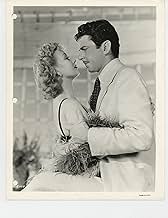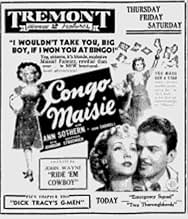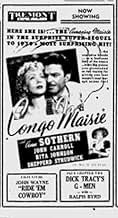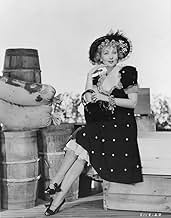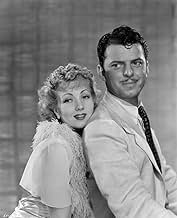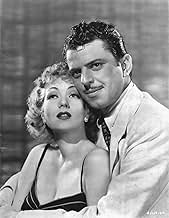अपनी भाषा में प्लॉट जोड़ेंBrooklyn showgirl Maisie gets stranded in the African jungle with a romantic doctor.Brooklyn showgirl Maisie gets stranded in the African jungle with a romantic doctor.Brooklyn showgirl Maisie gets stranded in the African jungle with a romantic doctor.
- पुरस्कार
- कुल 2 जीत
William Broadus
- Third Witch Doctor
- (बिना क्रेडिट के)
Tom Farrell
- Sergeant
- (बिना क्रेडिट के)
Joel Fluellen
- Native
- (बिना क्रेडिट के)
Buddy Harris
- Second Witch Doctor
- (बिना क्रेडिट के)
Darby Jones
- First Witch Doctor
- (बिना क्रेडिट के)
फ़ीचर्ड समीक्षाएं
"Congo Maisie" is the second film of what would be a 10-fim series of comedies mixed with other genres by MGM from 1939 to 1947. The first film , "Maisie" of 1939, had been planned for Jean Harlow in 1937 until she died suddenly of liver disease. Ann Sothern was picked for her role two years later and did so well that MGM had its writers churn out nine more tales based on the Maisie Ravier character.
In these early films, Maisie is usually playing a club dancer and singer who's between jobs or enroute to another one. But here she happens to be in British West Africa, just before World War II. The opening scene identifies it as Kurmala, West Africa, and it appears to be on the coast at the mouth of the Congo River. That might be present day Muanda of the Democratic Republic of the Congo.
The movie opens with Maisie sneaking out of her hotel to avoid the proprietor because she can't pay her bill. She stows away on a boat that she thinks will be traveling along the coast. So, she's surprised when she finds out its going a good distance up the Congo. And that's where this comedy drama takes place. The boat engine conks out and Maisie and the male passenger, Dr. Michael Shane, have to walk a couple miles to the Atkinson Rubber Co. Medical station, where he used to work.
This story centers around the former doctor who's now trying to make it big running a plantation. But when the new doctors takes ill, he has to again practice medicine. Besides helping the doctor with his practice, Maisie helps stem a medicine-man provoked uprising with some magic of her own. And, she helps save the stations doctor's marriage. Naturally, the comedy is quite low-key in such a setting, but it's a good and entertaining film.
Here are some favorite lines.
Nelson, "Have you seen anything of a blonde?" Captain Finch, "Brother, where is she?" Nelson, "That's what I'm asking you. Are you sure that there ain't been no blonde with a suitcase stowed away on this boat within the last couple of hours?" Captain Finch: "Listen, silly, if there was a blonde on board, would I be out here talkin' to you? You've got it easy. You're behind that face. Brother, from the front it's terrible."
Captain Finch, "And don't ever offer anybody money like that - in the presence of witnesses."
Maisie Ravier, "Hey, what happens to me? Can I come along?" Dr. Michael Shane, "Suit yourself." Maisie, "Well, it's you or the crocodiles, and they got more teeth."
Maisie Ravier, "What was that?" Dr. Michael Shane, "A baboon drumming." Maisie, "Now, who'd give a baboon a drum, missionaries?"
Maisie Ravier, "Hmh. All the modern conveniences. Electric lights, hot and cold running monkeys...."
Maisie Ravier, "Hey, wait a minute. This is not how you look at a place. I've even had fun in Philadelphia - in good company."
Dr. Michael Shane, "I spent five years serving humanity. Now I'm looking out for Michael Shane." Dr. John McWade, "I didn't know you could measure service to humanity five years and then no more."
Dr. Michael Shane, "Little girls who listen at key holes don't go to heaven." Maisie, "I know, but sometimes you get a chance to help someone you like and I like that Mrs. McWade."
Maisie Ravier, "You better operate." Dr. Michael Shane, "I'm not practicing medicine." Maisie, "Have you stopped practicing being a man?"
Dr. Michael Shane, "I'm going to take that out, McWade. I know you don't like me, but my worst enemy will tell you that I'm handy with a knife."
In these early films, Maisie is usually playing a club dancer and singer who's between jobs or enroute to another one. But here she happens to be in British West Africa, just before World War II. The opening scene identifies it as Kurmala, West Africa, and it appears to be on the coast at the mouth of the Congo River. That might be present day Muanda of the Democratic Republic of the Congo.
The movie opens with Maisie sneaking out of her hotel to avoid the proprietor because she can't pay her bill. She stows away on a boat that she thinks will be traveling along the coast. So, she's surprised when she finds out its going a good distance up the Congo. And that's where this comedy drama takes place. The boat engine conks out and Maisie and the male passenger, Dr. Michael Shane, have to walk a couple miles to the Atkinson Rubber Co. Medical station, where he used to work.
This story centers around the former doctor who's now trying to make it big running a plantation. But when the new doctors takes ill, he has to again practice medicine. Besides helping the doctor with his practice, Maisie helps stem a medicine-man provoked uprising with some magic of her own. And, she helps save the stations doctor's marriage. Naturally, the comedy is quite low-key in such a setting, but it's a good and entertaining film.
Here are some favorite lines.
Nelson, "Have you seen anything of a blonde?" Captain Finch, "Brother, where is she?" Nelson, "That's what I'm asking you. Are you sure that there ain't been no blonde with a suitcase stowed away on this boat within the last couple of hours?" Captain Finch: "Listen, silly, if there was a blonde on board, would I be out here talkin' to you? You've got it easy. You're behind that face. Brother, from the front it's terrible."
Captain Finch, "And don't ever offer anybody money like that - in the presence of witnesses."
Maisie Ravier, "Hey, what happens to me? Can I come along?" Dr. Michael Shane, "Suit yourself." Maisie, "Well, it's you or the crocodiles, and they got more teeth."
Maisie Ravier, "What was that?" Dr. Michael Shane, "A baboon drumming." Maisie, "Now, who'd give a baboon a drum, missionaries?"
Maisie Ravier, "Hmh. All the modern conveniences. Electric lights, hot and cold running monkeys...."
Maisie Ravier, "Hey, wait a minute. This is not how you look at a place. I've even had fun in Philadelphia - in good company."
Dr. Michael Shane, "I spent five years serving humanity. Now I'm looking out for Michael Shane." Dr. John McWade, "I didn't know you could measure service to humanity five years and then no more."
Dr. Michael Shane, "Little girls who listen at key holes don't go to heaven." Maisie, "I know, but sometimes you get a chance to help someone you like and I like that Mrs. McWade."
Maisie Ravier, "You better operate." Dr. Michael Shane, "I'm not practicing medicine." Maisie, "Have you stopped practicing being a man?"
Dr. Michael Shane, "I'm going to take that out, McWade. I know you don't like me, but my worst enemy will tell you that I'm handy with a knife."
This time, just call Maisie "Congo Maisie" in this 1940 second entry into the "Maisie" series. Each episode of Maisie's fabulous life is done as a separate entity as if the previous one never happened. So don't get too attached to anyone.
Maisie, stranded as usual, stows away on a ship that doesn't go the way she wants and, in fact, breaks down. She tags along with a rubber plantation manager (John Carroll) when he hikes to his old house where he worked as a doctor (he's since forsaken the Hippocratic oath). Now it's the home of a doctor who does research (Sheppard Strudwick) and his wife (Rita Johnson).
"Congo Maisie" is chock full of adventure, with Maisie assisting in an emergency operation and, wearing a gown and a Carmen Miranda headpiece from her club act, fends off witch doctors.
It's quite funny but as my sister yelled out to me hearing some of it, "Is that a politically incorrect movie you're watching in there?" Uh, yeah.
John Carroll is the new object of Maisie's affections. He talks a lot and uses a monotone that becomes grating real fast. I recall a photo of him where he was presented as a Gable wannabe. Forget it. Rita Johnson is absolutely lovely, and Sheppard Strudwick is very good. Fun.
Maisie, stranded as usual, stows away on a ship that doesn't go the way she wants and, in fact, breaks down. She tags along with a rubber plantation manager (John Carroll) when he hikes to his old house where he worked as a doctor (he's since forsaken the Hippocratic oath). Now it's the home of a doctor who does research (Sheppard Strudwick) and his wife (Rita Johnson).
"Congo Maisie" is chock full of adventure, with Maisie assisting in an emergency operation and, wearing a gown and a Carmen Miranda headpiece from her club act, fends off witch doctors.
It's quite funny but as my sister yelled out to me hearing some of it, "Is that a politically incorrect movie you're watching in there?" Uh, yeah.
John Carroll is the new object of Maisie's affections. He talks a lot and uses a monotone that becomes grating real fast. I recall a photo of him where he was presented as a Gable wannabe. Forget it. Rita Johnson is absolutely lovely, and Sheppard Strudwick is very good. Fun.
MGM's Tarzan sets got some extra use when in Ann Sothern's Maisie series she did an African film Congo Maisie. The plot which was recycled from Red Dust would get recycled again for Mogambo only that one was actually done on African location.
Ann Sothern stows away on the wrong boat, she has a job in a coastal African town, but this boat commanded by J.M. Kerrigan is going upstream to a small settlement, a research facility where married couple Sheppard Strudwick and Rita Johnson. Even further into the wild is another former doctor now rubber plantation magnate John Carroll and all three go visiting there.
Where both an outbreak of witch doctor fundamentalism and an attack of appendicitis on Strudwick puts the whole party in jeopardy. But not with the ever resourceful Maisie using some tricks she learned from when she was a magician's apprentice.
Using her Maisie character as a bridge between what Jean Harlow and later Ava Gardner did with same part, Sothern is light, breezy, entertaining and very wise in a street smart way. The Maisie series went on for about a decade and Sothern's ingratiating and affable personality was the reason why.
We could all use a wise Maisie in our lives.
Ann Sothern stows away on the wrong boat, she has a job in a coastal African town, but this boat commanded by J.M. Kerrigan is going upstream to a small settlement, a research facility where married couple Sheppard Strudwick and Rita Johnson. Even further into the wild is another former doctor now rubber plantation magnate John Carroll and all three go visiting there.
Where both an outbreak of witch doctor fundamentalism and an attack of appendicitis on Strudwick puts the whole party in jeopardy. But not with the ever resourceful Maisie using some tricks she learned from when she was a magician's apprentice.
Using her Maisie character as a bridge between what Jean Harlow and later Ava Gardner did with same part, Sothern is light, breezy, entertaining and very wise in a street smart way. The Maisie series went on for about a decade and Sothern's ingratiating and affable personality was the reason why.
We could all use a wise Maisie in our lives.
Maisie is Maisie. Always enjoyable, but never rising to the level of series like The Thin Man. I like them as much as Blondie and a little better than Torchy. If you liked the first one you can certainly bask in this mix of seriousness and silliness.
Typically, some people are upset that the African characters are not all depicted as surgeons or poets. Oddly, these guardians of the film world end up minimizing the contributions of the black actors and the importance of the African characters (e.g., Everett Brown as Jallah).
Third World riots aren't pretty (they share this quality with First World riots). Hollywood would film it different today, but they'd also ruin the movie with politics. To enjoy old movies we have to accept that things were different then.
My rating (7/10) is measuring Congo Maisie against other movies in the series and against other series movies of the same type.
Typically, some people are upset that the African characters are not all depicted as surgeons or poets. Oddly, these guardians of the film world end up minimizing the contributions of the black actors and the importance of the African characters (e.g., Everett Brown as Jallah).
Third World riots aren't pretty (they share this quality with First World riots). Hollywood would film it different today, but they'd also ruin the movie with politics. To enjoy old movies we have to accept that things were different then.
My rating (7/10) is measuring Congo Maisie against other movies in the series and against other series movies of the same type.
During the late 30s and through the 40s, Ann Sothern made ten Maisie films. They were clearly B-movies--short, relatively low budget (for MGM) and meant as second films in a double-feature. Yet, despite this, they also were very polished and entertaining. Clearly, MGM made nice looking B-films.
In this second installment, Maisie is inexplicably in central Africa! Why is never really explained well and seeing the blonde Sothern traipsing about what is supposed to be African jungle is rather surreal. As far as the plot goes, it's a reworking of "Red Dust" but due to the Production Code, the sexiness of the remake is much more subdued than the original. In the original, Jean Harlow was a tramp--a nice tramp but clearly a tramp. Here, Maisie is a nice girl--a show girl but a NICE show girl.
When the film begins, Maisie stows away on a boat. Instead of heading down river to Lagos, it heads up river to disease-ridden and superstition-filled jungle. Along the way, she teams up with a grumpy ex-doctor, Dr. Shane (John Carrol), and they head to a jungle hospital--where the "Red Dust"-like plot ensues. There, another doctor's wife is bored and lonely and immediately falls for Dr. Shane. But, Maisie being a good girl, she does what she can to help the lady realize her problems WON'T be solved with an affair. How all this works out you'll just have to see for yourself.
Aside from stealing a few clips from "Trader Horn", the film looks pretty good for a stage-bound B-movie set in the jungle. And, the acting and story work well. Overall, it's an agreeable little film and a decent remake since the story is more a reworking than a direct remake. Worth your time even if it is a bit patronizing in how it depicts many of the Africans.
In this second installment, Maisie is inexplicably in central Africa! Why is never really explained well and seeing the blonde Sothern traipsing about what is supposed to be African jungle is rather surreal. As far as the plot goes, it's a reworking of "Red Dust" but due to the Production Code, the sexiness of the remake is much more subdued than the original. In the original, Jean Harlow was a tramp--a nice tramp but clearly a tramp. Here, Maisie is a nice girl--a show girl but a NICE show girl.
When the film begins, Maisie stows away on a boat. Instead of heading down river to Lagos, it heads up river to disease-ridden and superstition-filled jungle. Along the way, she teams up with a grumpy ex-doctor, Dr. Shane (John Carrol), and they head to a jungle hospital--where the "Red Dust"-like plot ensues. There, another doctor's wife is bored and lonely and immediately falls for Dr. Shane. But, Maisie being a good girl, she does what she can to help the lady realize her problems WON'T be solved with an affair. How all this works out you'll just have to see for yourself.
Aside from stealing a few clips from "Trader Horn", the film looks pretty good for a stage-bound B-movie set in the jungle. And, the acting and story work well. Overall, it's an agreeable little film and a decent remake since the story is more a reworking than a direct remake. Worth your time even if it is a bit patronizing in how it depicts many of the Africans.
क्या आपको पता है
- ट्रिवियाThis film is based on the 1934 novel "Congo Landing" by Wilson Collison and is not a remake of Red Dust (1932). Although the two films are similar, and promotional material for Congo Maisie compared them, Red Dust was based on the 1928 play of the same name, also by Collison. The play was adapted in a second version as Mogambo (1953) with the setting changed from Indochina to Africa.
- गूफ़When Dr. Shane is trying to hold off the natives at the end, Maisie comes out and does some magic tricks - a color-changing scarf, and cards appearing from nowhere. Dr. Shane tells her to do more, and she says that's all she has. Yet earlier, she was doing a trick with a disappearing ball. And later she comes out doing a water trick.
- भाव
Dr. Michael Shane: Little girls that listen at keyholes don't go to heaven.
- कनेक्शनFollowed by Gold Rush Maisie (1940)
टॉप पसंद
रेटिंग देने के लिए साइन-इन करें और वैयक्तिकृत सुझावों के लिए वॉचलिस्ट करें
विवरण
- रिलीज़ की तारीख़
- कंट्री ऑफ़ ओरिजिन
- भाषा
- इस रूप में भी जाना जाता है
- Boginja Konga
- फ़िल्माने की जगहें
- उत्पादन कंपनी
- IMDbPro पर और कंपनी क्रेडिट देखें
- चलने की अवधि1 घंटा 11 मिनट
- रंग
- पक्ष अनुपात
- 1.37 : 1
इस पेज में योगदान दें
किसी बदलाव का सुझाव दें या अनुपलब्ध कॉन्टेंट जोड़ें



